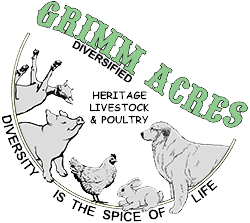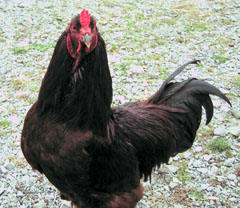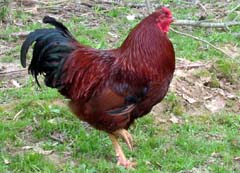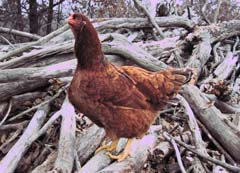Poultry For Sale
Poultry
Bourbon Red Turkeys
Named for Bourbon County, Kentucky where it was originated in the late 1800's, the Bourbon Red Turkey is a stately turkey with a rich bourbon red with color accented by white wings and tail feathers. Children visiting us at Grimm Acres tell us that they look just like the turkey in "pictures" of the pilgrims on the first Thanksgiving. Although the tom's favorite pastime seems to be teasing the dogs into a frenzy of barking, they have never been aggressive with any of us or our visitors. We did make the mistake of feeding them by hand for a while, but then found the large birds jumping up and trying to snatch anything we were carrying out of our hands like keys or a cup of coffee! Our turkey hens are very broody wanting to sit on their eggs even in the winter. They are attentive mothers and will even raise the occasional chicken chick when a hen has left her egg in the turkey nest. Active foragers, we have found the Bourbon Red a comfortable fit for our pastured system. Their curiosity and social disposition leads them to congregate near the driveway when anything "interesting" is gong on. And they are quite ornamental with their broad tails and deep red wattles. The meat is rich and flavorful, with a nice heavy breast. The toms weigh on the average 20 to 22 pounds, and the hens are 12 to 14.
Welsh Harlequin Ducks
Listed by the ALBC as "Critical" our Welsh Harlequin Ducks are a beautiful addition to the pasture. The drakes often remind visitors of mallard ducks with their rich greenish black feathers, accented with chestnut and frosted white. The Welsh Harlequin duck is dramatically different with a creamy white head touched with brown. Her body is also creamy white with touches of brown, and bronze. Together they make a very striking pair. These ducks are among the most prolific egg layers of all ducks. They will lay between 250 and 300 eggs each year. Because they are very active foragers, their white shelled eggs contain a beautiful golden orange yolk. Since Ducks don't scratch like chickens do, we love them around the garden where one of their favorite meals is snails and slugs. The ducks are broody if given a chance and ours have hatched a nest of ducklings in her outside nest several times. When butchered, these lightweight ducks, weighing 5 to 6 pounds, produce nice lean, flavorful meat.
Faun Runner Ducks
One of the favorite attractions here at Grimm Acres, Diversified is our small flock of Runner Ducks. Their legs are set farther back on their bodies than other ducks, and the walk, or more often, run with an upright stance that makes them look a bit like "wine bottles with heads" scooting across the field. The Runner Duck's history reaches back 2000 years in Indo China where herds were driven to fields and rice paddies to glean weed seeds, snails, and various insects assisting the farmer to grow a better crop. The ducks would be driven home at night to the protection of a small shelter or pen where their eggs could be gathered for the family. At Grimm Acres, we love the aggressive way these ducks devour insects, especially the snails that can be a link in the life cycle of several livestock parasites. Though small ducks, weighing in at around 4 pounds, they will lay better than 200 white eggs a year. Runner Ducks are excellent foragers, easy to keep, and an exceptionally entertaining addition to the farm.
Buckeye Chickens
A great representative of the dual purpose chicken that was once a favorite on small farms across the U.S. is the Buckeye. Buckeyes are nice large chickens with roosters weighing around 9 pounds and hen weighing approximately six and a half. They dress out very nicely with meaty thighs and a good sized breast. The hens lay a medium to large sized egg with a beautiful brown shell. These chickens are very active foragers and consequently the yolk of the eggs is rich and golden. The only American Class of chicken developed entirely by a woman, the Buckeye is currently our favorite chicken here at Grimm Acres. Mrs. Nettie Metcalf, the developer, named them after the deep red plumage, almost the color of a polished buckeye. She bred them with a pea comb which helps them to be very cold hardy, and much less susceptible to frostbite then other chickens. Buckeyes are so aggressive in chasing mice that some people compare them to cats. At the same time they are calm and friendly around people. We have never had even a rooster be aggressive to any of us or our visitors. Though somewhat similar in appearance, Buckeyes should not be confused with the Rhode Island Red. Interestingly, the Buckeye was actually popular in the mid-west earlier than the Rhode Island Red. These great, dual purpose chickens are listed by the ALBC as "Critical", so are actually at risk of disappearing completely. We believe this would be a great tragedy and strongly encourage others to take a look at these heritage birds.
Guinea Fowl
We really love our Guineas. They are a rather bizarre chicken-like bird that looks a bit like an escapee from Jurassic Park (1993). They fly very well, and so roam pretty much where they want to go. Ours always come home to a large tree in our back yard to roost at night. These unusual birds mate for life, which makes them a bit more interesting to me than chickens. They like to be in a flock, but pair off to move about the pasture hunting the insects, especially ticks (!) that makes up most of their diet. Our Guineas eat with the chickens early in the day, but pretty much fend for themselves the rest of the time, making them very economical to keep. Guineas are notorious for their loud cry when anything threatening or unusual happens. They are our "First Line of Defense" when raccoons, foxes or stray dogs approach the chicken houses. Their loud "Pe-Turk" draws the Pyrenees attention to even the most stealthy of predators. Our favorite thing about the Guineas is their efficiency in lowering the tick population on our farm.
Guineas Fighting TicksAccording to Wikipedia, "(Guineafowl) eat lice, worms, ants, spiders, weed seeds, and ticks while on range, or they can also eat chicken layer crumbles (one kind of commercial bird feed) while housed in a coop. The cooked flesh of guineafowl resembles chicken in texture, with a flavor somewhere between chicken and turkey."
A paragraph from the Wilson Bullitin, (SUSAN M. SMITH, Dept. of Biological Sciences, Mount
Holyoke College, South Hadley, Massachusetts0 1075. ReceivedI I Aug. 1991, accepted1 2 Nov.
1991.., 104(2), 1992, pp. 342-345) says this about using Guinea fowl to reduce the numbers of
ticks in lawns:
"Our experiments suggest that predation by guineafowl reduced numbers of adult
deer ticks on lawns adjacent to dense foliage at two sites on Long Island. Adult deer ticks have a
50-100% probability of being infected with the Lyme disease spirochete (Lane et al. 199 l), so the
presence of free-ranging guineafowl may help reduce the probability of contracting Lyme Disease
from adult ticks on lawns and lawn edges. In addition, guineafowl reduced the presence of other
arthropods, suggesting they may help reduce the need for chemical insecticides."
Buyers Agreement
We have a few requirements we would like to make prospective buyers aware of up front as to avoid any confusions or problems that might arise.
In compliance with the Animal Welfare Approved standards, young animals do not leave the farm at less than 12 weeks of age.
We and our vet would greatly appreciate 48-72 hours notice when a health certificate needs to be done.
A 50% down payment is required to reserve any animal. This 50% down payment is non-refundable.
Remember that the health certificate is only valid for 10 days after the vet signs it, so any delays in pickup beyond that time will incur billing for a second health certificate.
If you have any questions, concerns, or are wondering about something that we have not covered please do not hesitate to contact us.







